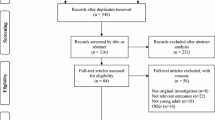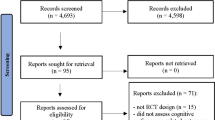Abstract
Objectives
The aim of the present cross-sectional study was to provide estimates for overweight and obesity in a sample of Greek schoolchildren and to determine their possible relation with selected motor and health-related fitness parameters.
Materials and methods
The study sample consisted of 709 healthy children (328 girls, 381 boys, mean age = 8.9±1.6 years), living in the towns of Agios Stefanos (∼12 000 citizens) and Alexandroupolis (∼60 000 citizens), Greece. All pupils underwent anthropometric, motor and cardiovascular fitness assessments (Eurofit test battery). The body mass index (BMI) cut-off points adopted by the International Obesity Task Force were utilized for the assessment of overweight and obesity.
Results
59.4% of the participants had a normal BMI, 25.8% were overweight and 14.8% were obese, without significant differences between genders.
Discussions
In general, the higher BMI categories were strongly associated with inferior performances in all fitness tests, except flexibility. This graded relationship was consistent for both boys and girls, although the statistical relationship between BMI categories and fitness performance varied by gender.
Conclusions
In conclusion, the findings of the current study offer some support to the reported high prevalence of childhood obesity in Greece and suggest that overweight and obesity are limiting factors for fitness performance in primary schoolchildren. The present data suggest that interventions promoting children’s health should, ideally, begin early in life and involve measures that simultaneously improve fitness and lower fatness.


Similar content being viewed by others
Abbreviations
- BMI:
-
Body mass index
- IOTF:
-
International obesity task force
- SAR:
-
Sit and reach test
- SUP:
-
Sit-up test
- ASR:
-
Agility shuttle run test
- MAT:
-
Multistage aerobic shuttle run test
References
American College of Sports Medicine Position Stand (1998) The recommended quantity and quality of exercise for developing and maintaining cardiorespiratory and muscular fitness, and flexibility in healthy adults. Med Sci Sports Exerc 30:975–991
Astrup A (1999) Macronutrient balances and obesity: the role of diet and physical activity. Public Health Nutr 2:341–347
Bailey DA (1973) Exercise, fitness and physical education for the growing child: a concern. Can J Public Health 64:421–430
Bellizzi MC, Dietz WH (1999) Workshop on childhood obesity: summary of the discussion. Am J Clin Nutr 70:173–175
Bouchard C (1990) Discussion: Heredity, fitness and health. In: Bouchard C, Shepard RJ, Stephens T, Sutton JR, McPherson BD (eds) Exercise, fitness and health. Human Kinetics, Champaign, IL, pp 147–153
Bouchard C, Dionne FT, Simoneau JA, Boulay MR (1992) Genetics of aerobic and anaerobic performances. In: Holloszy JO (ed) Exercise and sport sciences reviews. Williams and Wilkins, Baltimore, pp 27–58
Bouchard C, Perusse L, Leblanc C, Tremblay A, Theriault G (1988) Inheritance of the amount and distribution of human body fat. Int J Obes 12:205–215
Bouziotas C, Koutedakis Y (2003) A three year study of coronary heart disease risk factors in Greek adolescents. Ped Exerc Sci 15:9–18
Brewer J, Ramsbottom R, Williams C (1988) Multistage fitness test. A progressive shuttle run test for the prediction of maximum oxygen uptake. National Coaching Foundation, Leeds, UK
Cole TJ, Bellizzi C, Flegal KM, Dietz WH (2000) Establishing a standard definition for child overweight and obesity worldwide: international survey. BMJ 320(7244):1240–1253
Committee of Experts on Sports Research (1988) European test of physical fitness (EUROFIT). Edigraf Editoriale Grafica, Rome
Crawford PB, Story M, Wang MC, Ritchie LD, Sabry ZI (2001) Ethnic issues in the epidemiology of childhood obesity. Pediatr Clin North Am 48(4):855–878
De Vito E, La Torre G, Langianno E, Berardi D, Ricciardi G (1999) Overweight and obesity among secondary school children in Central Italy. Eur J Epidemiol 15(7):649–54
Deforche B, Lefevre J, De Bourdeaudhuij I, Hills AP, Duquet W, Bouckaert J (2003) Physical fitness and physical activity in obese and nonobese Flemish youth. Obes Res 11(3):434–441
Ekelund U, Poortvliet E, Nilsson A, Yngve A, Holmberg A, Sjostrom M (2001) Physical activity in relation to aerobic fitness and body fat in 14- to 15-year-old boys and girls. Eur J Appl Physiol 85(3–4):195–201
Faude O, Nowacki PE, Urhausen A (2004) Vergleich ausgewaehlter (unblutiger) Testverfahren zur Bestimmung der kardiopulmonalen Ausdauer bei Schulkindern (Comparison of non-invasive tests to assess cardio-respiratory fitness in school children). Dtsch Z Sportmed 55(9):232–236
Frontini MG, Bao W, Elkasabany A, Srinivasan SR, Berenson G (2001) Comparison of weight-for-height indices as a measure of adiposity and cardiovascular risk from childhood to young adulthood: the Bogalusa heart study. J Clin Epidemiol 54:817–822
General Secretariat of National Statistical Service of Greece (2005) Statistical data - census of population 2001. http://www.statistics.gr. Cited 20 January 2005
Grund A, Dilba B, Forberger K, Krause H, Siewers M, Rieckert H, Müller MJ (2000) Relationships between physical activity, physical fitness, muscle strength and nutritional state in 5- to 11-year-old children. Eur J Appl Physiol 82(5–6):425–438
Huang YC, Malina RM (2002) Physical activity and health-related physical fitness in Taiwanese adolescents. J Physiol Anthropol Appl Human Sci 21(1):11–19
International Life Sciences Institute Europe - Overweight and Obesity in Children Task Force (2000) Report on overweight and obesity in European children and adolescents: causes and consequences - prevention and treatment. ILSI Press, Brussels
Johnson MS, Figueroa-Colon R, Herd SL, Fields DA, Sun M, Hunter GR, Goran MI (2000) Aerobic fitness, not energy expenditure, influences subsequent increase in adiposity in black and white children. Pediatrics 106(4):E50. http://www.pediatrics.org. Cited 23 May 2005
Karayiannis D, Yannakoulia M, Terzidou M, Sidossis LS, Kokkevi A (2003) Prevalence of overweight and obesity in Greek school-aged children and adolescents. Eur J Clin Nutr 57(9):1189–1192
Katzmarzyk PT, Gagnon J, Leon AS, Skinner JS, Wilmore JH, Rao DC, Bouchard C (2001) Fitness, fatness, and estimated coronary heart disease risk: the HERITAGE family study. Med Sci Sports Exerc 33:585–590
Katzmarzyk PT, Tremblay A, Perusse L, Despres JP, Bouchard C (2003) The utility of the international child and adolescent overweight guidelines for predicting coronary heart disease risk factors. J Clin Epidemiol 56(5):456–462
Klein M, Emrich E, Schwarz M, Papathanassiou V, Pitsch W, Kindermann W, Urhausen A (2004) Sportmotorische Leistungsfähigkeit von Kindern und Jugendlichen im Saarland - Ausgewählte Ergebnisse der IDEFIKS-Studie (Teil 2) [Sport-motoric performance capacity of children and adolescents in the Saarland - Selected results of the IDEFIKS-Study (Part 2)]. Dtsch Z Sportmed 55(9):211–220
Koutedakis Y, Bouziotas C, Flouris AD, Nelson PN (2005) Longitudinal modeling of adiposity in periadolescent Greek schoolchildren. Med Sci Sports Exerc 37(12):2070–2074
Krassas GE, Tzotzas T, Tsametis C, Konstantinidis T (2001) Prevalence and trends in overweight and obesity among children and adolescents in Thessaloniki, Greece. J Pediatr Endocrinol Metab 14(Suppl 5):1319–1326
Leger LA, Mercier D, Gaboury C, Lambert J (1988) The multistage 20-m shuttle run test for aerobic fitness. J Sports Sci 6(2):93–101
Leung AK, Robson WL (1990) Childhood obesity. Postgrad Med 87:123–130
Lindsay RS, Hanson RL, Roumain J, Ravussin E, Knowler WC, Tataranni PA (2001) Body mass index as a measure of adiposity in children and adolescents: relationship to adiposity by dual energy x-ray absorptiometry and to cardiovascular risk factors. J Clin Endocrinol Metab 86(9):4061–4067
Lissau I, Overpeck MD, Ruan WJ, Due P, Holstein BE, Hediger ML (2004) Body mass index and overweight in adolescents in 13 European countries, Israel, and the United States. Arch Pediatr Adolesc Med 158(1):27–33
Magkos F, Manios Y, Christakis G, Kafatos AG (2005) Secular trends in cardiovascular risk factors among school-aged boys from Crete, Greece, 1982–2002. Eur J Clin Nutr 59:1–7
Malina RM, Beunen GP, Classens AL, Lefevre J, Vanden Eynde BV, Renson R, Vanreusel B, Simons J (1995) Fatness and physical fitness of girls 7 to 17 years. Obes Res 3(3):221–231
Mamalakis G, Kafatos A, Manios Y, Anagnostopoulou T, Apostolaki I (2000) Obesity indices in a cohort of primary school children in Crete: a six year prospective study. Int J Obes Relat Metab Disord 24(6):765–771
Manios Y, Yiannakouris N, Papoutsakis C, Moschonis G, Magkos F, Skenderi K, Zampelas A (2004) Behavioral and physiological indices related to BMI in a cohort of primary schoolchildren in Greece. Am J Hum Biol 16(6):639–647
McKenzie TL, Sallis JF, Broyles SL, Zive MM, Nader PR, Berry CC, Brennan JJ (2002) Childhood movement skills: predictors of physical activity in Anglo-American and Mexican American adolescents? Res Q Exerc Sport 73(3):238–244
Padez C, Fernandes T, Mourao I, Moreira P, Rosado V (2004) Prevalence of overweight and obesity in 7-9-year-old Portuguese children: trends in body mass index from 1970–2002. Am J Hum Biol 16(6):670–678
Pongprapai S, Mosuwan L, Leelasamran W (1994) Physical fitness of obese school children in Hat Yai, southern Thailand. Southeast Asian J Trop Med Public Health 25(2):354–360
Reeves L, Broeder CE, Kennedy-Honeycutt L, East C, Matney L (1999) Relationship of fitness and gross motor skills for five- to six-yr.-old children. Percept Mot Skills 89:739–747
Rocandio AM, Ansotegui L, Arroyo M (2001) Comparison of dietary intake among overweight and non-overweight schoolchildren. Int J Obes Relat Metab Disord 25:1651–1655
Salbe AD, Weyer C, Harper I, Lindsay RS, Ravussin E, Tataranni PA (2002) Assessing risk factors for obesity between childhood and adolescence: II. Energy metabolism and physical activity. Pediatrics 110(2):307–314
Stubbs CO, Lee AJ (2004) The obesity epidemic: both energy intake and physical activity contribute. MJA 181(9):489–491
Stunkard AJ, Berkowitz RI, Schoeller D, Maislin G, StallinIgs VA (2004) Predictors of body size in the first 2 y of life: a high-risk study of human obesity. Int J Obes Relat Metab Disord 28(4):503–513
Sur H, Kolotourou M, Dimitriou M, Kocaoglu B, Keskin Y, Hayran O, Manios Y (2005) Biochemical and behavioral indices related to BMI in schoolchildren in urban Turkey. Prev Med 41(2):614–621
Togashi K, Masuda H, Rankinen T, Tanaka S, Bouchard C, Kamiya H (2002) A 12-year follow-up study of treated obese children in Japan. Int J Obes Relat Metab Disord 26(6):770–777
Valerio G, Scalfi L, De Martino C, Franzese A, Tenore A, Contaldo F (2003) Comparison between different methods to assess the prevalence of obesity in a sample of Italian children. J Pediatr Endocrinol Metab 16(2):211–216
Wabitsch M (2000) Overweight and obesity in European children: definition and diagnostic procedures, risk factors and consequences for later health outcome. Eur J Pediatr 159:8–13
Wang Y, Lobstein T (2006) Worldwide trends in childhood overweight and obesity. Int J Pediatr Obes 1:11–25
Zellner K, Jaeger U, Kromeyer-Hauschild K (2004) Height, weight and BMI of schoolchildren in Jena, Germany-are the secular changes leveling off? Econ Hum Biol 2:281–294
Author information
Authors and Affiliations
Corresponding author
Rights and permissions
About this article
Cite this article
Tokmakidis, S.P., Kasambalis, A. & Christodoulos, A.D. Fitness levels of Greek primary schoolchildren in relationship to overweight and obesity. Eur J Pediatr 165, 867–874 (2006). https://doi.org/10.1007/s00431-006-0176-2
Received:
Accepted:
Published:
Issue Date:
DOI: https://doi.org/10.1007/s00431-006-0176-2




